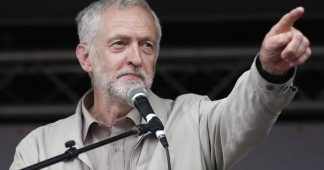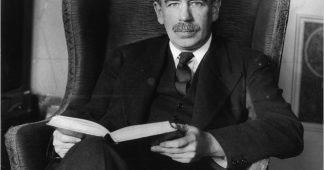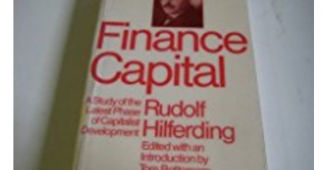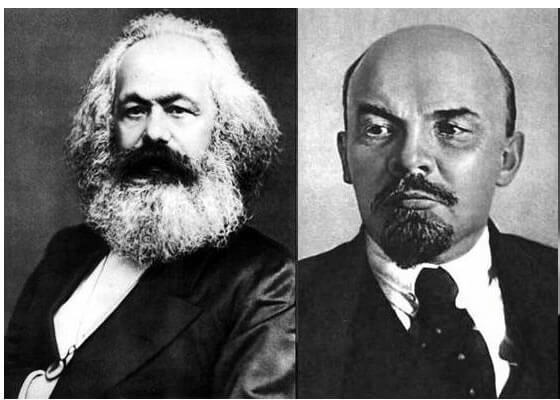October 10, 2012
I.
President Lyndon Johnson asked John Kenneth Galbraith to write him a speech on economic policy. After glancing at it LBJ said ‘You know Ken, the trouble with economics is it’s like peeing in your pants. It feels hot to you, but leaves everyone else cold’.
I felt a lot of sympathy with LBJ this afternoon when I listened to a couple of clever mathematicians having a lot of fun with their equations. I thought they were having too much fun – as economists! Good economists should not enjoy maths too much. Whenever they are tempted to show off, they should ask themselves: ‘Is this really necessary? Does it help tell the story I want to tell?’
I also very much agreed with Jamie Galbraith that the story we tell has to go beyond Keynes.
I want to contribute to that broadening this evening by drawing your attention to two non-Keynesian traditions which throw light on the present crisis: those which emphasise the income inequality and those which emphasise power. In other words, Hobson and Marx.
Fundamental to Keynes are the concepts of uncertainty and under-employment equilibrium. From Hobson we get an understanding of how inequality of wealth and income makes crisis more likely and recovery more difficult. From Marx we get an explanation of why inequality of wealth and income is inherent in an unmodified capitalist system. We need to put together the three accounts in order to achieve a fuller understanding of the events through which we have recently been living.
Keynes began the last chapter of the GT as follows:
‘The outstanding faults of the economic society in which we live are its failure to provide for full employment and its arbitrary and inequitable distribution of wealth and incomes’. (GT,372)
In the Keynesian short-run model, income distribution played no causal role: Keynes took distribution as given. However, in thinking about the movement of the economy through time, he attached more importance to distributional questions: ‘Experience suggests…that measures for the redistribution of income in a way likely to raise the propensity to consume may prove positively favourable to the growth of capital’. (GT, 373)
This brings him closer to the under-consumptionists and Marxists. I want to compare his his analysis of capitalist crisis with those of Hobson and Marx, first in a ‘closed’, then in an ‘open’, economy framework.
II.
Let’s start with the closed economy case. The strong message of the GT is that investment is the unruly element in a decentralised market economy, because of the existence of irreducible uncertainty. What Keynes calls the ‘pretty, polite techniques’ of economics blind us to the fact that we normally don’t have a clue what the consequences of our investment decisions will be, and are therefore inordinately subject to herd behaviour. So it is an autonomous collapse in investment prospects -for whatever reason – that usually triggers off the slump.
There is also in Keynes’s economy no automatic recovery mechanism, so that, in the absence of an external stimulus, a collapsed economy might get stuck in a situation of semi-slump.. He called this ‘under-employment equilibrium’. This equilibrium, like others, was not a state of absolute repose, but a point of gravitational attraction, round which the business cycle continued.
I believe the present crisis exhibits the truth of both parts of this analysis: we had a collapse of ‘animal spirits’ in 2007-8 and have had an invalid economy ever since, at least in the developed world.
Let me contrast this kind of analysis with that of Keynes’s near contemporary, J. A. Hobson. Hobson says that because of the unequal distribution of wealth and income, households are left with too little purchasing power to buy the products they help produce. Or to put it more exactly: the excessive gap between consumption and production or, what is identical, ‘excess saving’ causes more to be produced than the remaining income for consumption can buy at prices profitable to their producers. So society periodically finds itself with too much capital. The result is collapse.
This has some affinity with Karl Marx’s theory of capitalist crisis, at least to one of his theories. Marx says that because the working class is deprived of its share of productivity growth, it lacks the means to buy the ever increasing volume of goods produced by its labour. So like Hobson’s economy, Marx’s suffers from periodic ‘crises of realization’.
A typical underconsumptionist analysis of the Great Depression was given by Marriner Eccles, chairman of the Fed 1934-1948:
‘A mass production economy has to be accompanied by mass consumption. Mass consumption in turn implies a distribution of wealth to provide men with buying power. Instead of achieving that kind of distribution, a giant suction pump had by 1929 drawn into a few hands an increasing proportion of currently produced wealth.
This served them as capital accumulation. But by taking purchasing power out of the hands of mass consumers, the savers denied to themselves the kind of effective demand for their products that would justify a reinvestment of their capital accumulations in new plants. In consequences, as in a poker game when the chips were concentrated in fewer and fewer hands, the other fellows could stay in the game only by borrowing. When their credit ran out, the game stopped’. (Marriner Eccles, Beckoning Frontiers: Public and Personel Recollections p.79)
If this comes with a shock of recognition, that, I think, is a plus for under-consumption theory.
Unlike Keynes, Hobson and Marx were business cycle theorists. The collapses, however severe, do generate recoveries. In Hobson’s scenario, as the depression deepens, the ‘saving class’ finds its income is reduced, but it makes no attempt to reduce its standard of living -Hobson calls this the ‘conservation of consumption’ -and this reduces the saving ratio to ‘normal’. Marx’s economy is able to recover by expanding the ‘reserve army of the unemployed’. This may reduce consumption power even further, but enables the capitalist class to restore the profit rate by appropriating even more ‘surplus value’. The second effect is more powerful. Both remedies are temporary, though, and the next boom infallibly produces the next depression.
Both Hobson and Marx did suggest permanent remedies. Hobson wanted to redistribute wealth and income in order to reduce the saving share in national income. Marx’s more radical cure, as we know, was to abolish capitalism.
Keynes never engaged properly with Marx. He found him unintelligible and unreadable. But Hobson was an English liberal like himself, and he took him seriously. He also saw some affinities between his views and Hobson’s, because like him, Hobson challenged the core classical belief that saving is always good. ‘In challenging the sovereign virtue of thrift’, Hobson wrote, ‘ I had put myself beyond the academic pale’.
In chapter 23 of the GT, Keynes quoted the following passage from Hobson’s The Physiology of Industry (1889), which Hobson had co-authored with a businessman A.F.Mummery:
‘Now saving, while it increases the existing aggregate of Capital, simultaneously reduces the quantity of utilities and conveniences consumed; any undue exercise of this habit must, therefore, cause an accumulation of capital in excess of that which is required for use, and this excess will exist in the form of general over-production’.
In this passage, Keynes wrote, can be found the ‘root of Hobson’s mistake’, namely ‘his supposing that it is a case of excessive saving causing the actual accumulation of capital in excess of what is required which is, in fact, a secondary evil which only occurs through mistakes of foresight; whereas the primary evil is a propensity to save in conditions of full employment more than the equivalent of the capital which is required, thus preventing full employment except when there is a mistake in foresight’.
Their theory was incomplete, Keynes suggested, because they had no ‘independent theory of the rate of interest’. This led Hobson to put too much stress on underconsumption leading to over-investment whereas the real problem was underinvestment relative to saving caused by ‘the rate of profit falling below the standard set by the rate of interest’. (GT, 366-8)
Keynes’s explanation of ‘under-investment’ was that people had the option of holding their savings in money rather than investing it and therefore there was no connection between the rate at which they wanted to save and the rate at which they wanted to invest.
‘Why’, Keynes asked in 1937, ‘should anyone outside a lunatic asylum wish to use money as a store of wealth?’ The answer he gave was that ”our desire to hold money is a barometer of our distrust of our own calculations and conventions concerning the future…The possession of actual money lulls our disquietude; and the premium which we require to make us part with money is the measure of our disquietude’ (CW, xiv, 115-6). That premium is the rate of interest. It is set by our ‘disquietude’, not by our saving. It cannot therefore be the mechanism which balances saving and investment, as classical economists said.
Keynes’s view of money as a store of wealth goes to the heart of our short-run problem. It means that collapses in the profitability of investment are not automatically offset by a fall in the rate of interest; in fact the rate of interest will tend to rise in line with our ‘disquietude’.
It also means that a policy of monetary expansion aimed at lowering the rate of interest may well fail if liquidity preference is rising faster than the central bank is printing money. This surely has been the fate of the recent bouts of Quantitative Easing on which Bernanke and Mervyn King put their hopes. Of an earlier, now forgotten, episode of QE in 1933, Keynes wrote ‘It is like trying to get fat by buying a larger belt’. (CW, xxi, 289-97)
While Keynes rejected the view that over-saving could be a cause of slump, he recognized that it was more difficult to maintain continuous full employment in an economy in which wealth and income are highly unequal.
We start with his ‘psychological law’, that the richer people are the more of their income they save, leaving a larger gap to be filled by investment ‘if the saving propensities of [society’] wealthier members are to be compatible with the employment of its poorer members’ (GT, 31). At the same time, the richer society grew, the fewer new investment opportunities there would be. Hence the problem of unemployment would worsen over time from both ends: in the growing gap between consumption and production and in the weakening inducement to invest.
So what should governments do? Keynes suggested three expedients: they could either increase their own spending out of loans, or they could use monetary policy to force down the long-run rate of interest, thus ridding capital of its ‘usurious’ aspects (‘euthanasia of the rentier’) or it could redistribute wealth and income in favour of those with the highest propensity to consume. In the ‘Concluding Notes’ to the GT, he wrote, only experience would show ‘how far it is safe to stimulate the average propensity to consume, without foregoing our aim of depriving capital of its scarcity-value within one or two generations’. (GT,377)
However, by 1943, he had sorted out his thoughts on the matter. He now envisaged three phases after the war. In Phase I, which he thought might last 5 years, investment demand would exceed full employment saving, leading to inflation in the absence of rationing and other controls. In this phase consumption should be restricted in order to reconstruct the war damaged industries.
In phase 2, which he thought might last between 5 and 10 years, he foresaw a rough equilibrium between full employment saving and private plus public investment, with the state pursuing an active investment policy.
In Phase 3, i.e. by about 1960, he thought that investment demand would be so saturated that it would not be able to match full employment saving without the state having to embark on wasteful and unnecessary programmes. In this phase, the aim of policy should be to encourage consumption and absorb some of the unwanted surplus of saving by increasing leisure and more frequent holidays. This would mark the entrance to the ‘golden age’ of capital abundance. Eventually Keynes thought that ‘depreciation funds would be almost sufficient to provide all the gross investment that is required’.
These remarks of 1943 link up with Keynes’s essay Economic Possibilities for our Grand childrern, written in 1930, which is the starting point of the book I have just written with my son, How Much is Enough?’.
By today Keynes thought we should have easily reached the stage in our affairs in which capital accumulation would no longer be so important. The rich economies would be producing enough consumption goods to satisfy all reasonable needs. So policy should aim to bring about a more equal distribution of wealth and more leisure.
In 1945, he reminded T.S. Eliot that ‘the full employment policy by means of investment’ was ‘only one particular application of an intellectual theorem. You can produce the result just as well by consuming more or working less. Personally I regarded the investment policy as first aid. It almost certainly will not do the trick. Less work is the ultimate solution (a 35 hour work week in the US would do the trick now). How you mix up these three ingredients is a matter of taste and experience, i.e. of morals and knowledge’.
Let me pause here to make one comment, because the point is often misunderstood. When Keynes called on the state to guarantee full employment -he meant a job for everyone looking for work not a guarantee of a certain quantity of work per week. He thought a full employment commitment would be quite consistent with people working on average a 30 or 20 or even 15 hour week. What he would have objected was our contemporary answer to the problem of automation –which is to force some people to work a lot more than they want, and others to work a lot less than they want, or not at all.
Keynes’s two mistakes, as we describe them in our book, was to underestimate technological progress, which constantly supplies us with new goods, and insatiability which constantly supplies us with new wants. Both push into a distant future Keynes’s golden age of capital abundance.
We have gone in the opposite direction to what he hoped. We are still fixated on economic growth, while abandoning any attempt to control the level or kind of investment. In order for growth to happen we encourage more and more consumption through advertising, while actively promoting inequality. And instead of the state embarking on wasteful and unnecessary investment programmes, we leave it to the financial sector to do this, wasting the money of investors in order to enrich a tiny minority, while the majority fall ever deeper into debt.
III.
I now want to consider how the theories I have been discussing play themselves out under ‘open economy’ conditions.
In a closed economy it is excess saving, according to Hobson, which causes periodic slumps. But an open economy provides an alternative: the domestic saver can lend abroad to develop new markets. Hobson called the need to find a foreign vent for excess saving the ‘economic taproot of imperialism’. This was taken up by Lenin to explain why capitalism hadn’t collapsed on time. Faced with a falling rate of profit, capitalists could restore their profit rate by opening up new territories for exploitation. So the export of capital was capitalism’s solution to the periodic crises caused by its unwillingness or inability to raise the real wages of workers.
Hobson saw that increased foreign investment requires an increase in net exports. So the export of capital solved two problems at once: it reduced the excess supply of goods and drained the pool of excess saving.
Unfortunately, this remedy – which both Hobson and Lenin called imperialism – only postponed the evil day. The competitive drive to capture new markets would lead to wars between the leading powers for the ‘division and redivision of the world’,
Their value of their analysis is it forces us to look more closely at the phenomenon of globalization. Is globalization the consequence of a benign and normal search for higher returns leading to a more efficient allocation of capital and production? Or is it an attempt to solve problems in the capital exporting countries, which would otherwise bring their economies crashing down?
Keynes sympathised with the Hobson/Lenin thesis in political economy terms, but his analytic starting point was different. Hobson and Lenin assumed that export of capital and foreign investment were one and the same thing, whereas for Keynes the problem was that foreign lending required, but did not receive, an equivalent increase in net investment. This is known in the literature as the ‘transfer problem’. Keynes first identified it when attacking the Allied demand for German reparations after the First World War. He then applied it to the British case. Unemployment in the UK was heavy after the war and orthodox policy was to encourage the export of capital to stimulate employment in the languishing export trades.
Keynes pointed out that the expansion of exports which a net transfer of money abroad required could be blocked at both ends: the capital exporting country might be unwilling or unable to increase its competitiveness sufficiently to allow the ‘real’ transfer of goods and services to take place; and the capital importing country might not be willing to suffer the loss of its own competitiveness. His argument was conducted in terms of a fixed exchange rate system, but it can be adapted to a system of managed floating.
If the increase in net exports was blocked, g old drained out of the capital exporter , forcing up its rate of interest, but there was no increase of exports to the rest of the world. As a result, the re was a global fall in demand.
The blocking mechanism in the capital gaining country could be tariffs, but Keynes concentrated on the case where its central bank ‘sterilized’ or ‘hoarded’ capital inflows in order to prevent a rise in its domestic price level. What it was doing in this case was to treat money as a ‘store of wealth’ rather than as a fund for investment. His story was based on what the US Fed was doing in the 1920s, but it can be readily applied to China today.
The accumulation of reserves by China started after the East Asian financial crisis in 1997-8: in Keynes’s language, the price of China’s disquietude had gone up.
Keynes’s involvement in the German reparations issue gave him a permanent bias in favour of debt forgiveness; his analysis of Britain’s unemployment problem in the 1920s, a permanent bias against capital exports.
The broad conclusion he drew was in line with that of Hobson and Lenin, but reached by a different route. To them capital exports solved the domestic unemployment problem, but at the expense of international conflict. To Keynes it also caused international conflict, but failed to solve the unemployment problem.
He wrote in 1936:
‘If nations can learn to provide themselves with full employment by their domestic policy….there would be no longer a pressing motive why one country need force its wares on another or repulse the offering of its neighbour…so as to develop a balance of trade in its own favour. International trade would cease to be what it is, namely a desperate expedient to maintain employment at home by forcing sales on foreign markets and restricting purchases which, if successful, will merely shift the problem of unemployment to the neighbour which is worsted in the struggle’.trying to solve your unemployment problem by exporting capital’. (GT, 382)
What I want to emphasise in this ‘open economy’ part of my lecture is the relevance of these analyses to the present problems of globalization. Keynes was the first economist, I think, to pinpoint unchecked reserve accumulation as the fly in the ointment of the classical international adjustment mechanism.
As he put it in 1941: ‘the process of adjustment is compulsory for the debtor and voluntary for the creditor. If the creditor does not choose to make, or allow his share of adjustment, he suffers no inconvenience. For whilst a country’s reserves cannot fall below zero, there is no ceiling which sets an upper limit. The same is true if international loans are to be the means of adjustment. The debtor must borrow, the creditor is under no compulsion to lend’. (CW, xxv, 28)
So the central aim of his plan for an International Clearing Union in 1941 was to prevent creditor ‘hoarding’. Otherwise the effects of freedom of capital movements will be violently perverse. No such mechanism was established by the Bretton Woods Agreement; and today international adjustment remains blocked.
Wherever we look in Keynes he keeps circling round the same issues: the role of money as the hedge against uncertainty; the consequences of this for economic activity; and the failure of the classical economics to understand it, because they did not recognise the existence of uncertainty.
IV.
I want to sum up what we can gain from all three of the thinkers I have been discussing.
From Keynes, it goes without saying, an analytic precision, lacking in Hobson and Marx, and the exposure of an irreducible problem for all forms of social interaction, not limited to economics: our lack of knowledge of any but the most immediate consequences of our actions. So, as he put, it wealth was a highly unsuitable object for the methods of the classical economist.
From Hobson, an understanding that structures of wealth and distribution can aggravate or mitigate the Keynes problem of unstable investment. Collapses due to uncertainty are more likely and more likely to be severe the more unequal is the distribution of wealth and incomes, and recoveries feebler.
From Marx we get an analysis of how unequal structures of wealth and incomes arise. This was lacking from Hobson: he never explained how savings got to be piled up in one place. And he could not do so, as long as he accepted that workers were paid their marginal product. Hobson did of course talk about monopoly, administered prices, and other distortions, but these contingent factors might be dealt with by reforms, and did not impugn the integrity of the classical theory of markets.
Marx did better by dropping the assumption that workers are paid their marginal products. If productivity growth outstrips wage growth, the gap between production and consumption will grow, resulting in an automatic rise in the savings ratio.
The ability of capitalists to pay workers less than they were worth and themselves more than they were worth rested, in Marx’v view, on their ownership of the means of production. This gave them power in the economy; and governments were subservient to that power.
Recent events have persuaded me that there is something intuitively right about the Marxist analysis. It is especially illuminating about globalisation. It seems to me quite reasonable to interpret the off-shoring of US production to China and East Asia as an attempt to restore the profitability of American capital by locating production in regions where labour was cheap and trade unions did not exist. This raises the crucial question of to what extent globalization as now practised is in the interests of the citizens of developed countries.
This brings me to my main criticism of Keynes. The idea that economic outcomes could be impacted by class power was beyond his ken. Essentially, unmanaged capitalist systems failed to maintain full employment because classical economics gave the wrong message. It assumed away uncertainty, and thereby mandated a high degree of laissez-faire. Light-touch regulation of the financial system was all that was needed because banks were optimally self-regulating.
In short, the flaw was theoretical, not structural. What was needed was a more accurate theory, not a redistribution of power. As Keynes famously put it at the end of the GT, ‘ideas’ are more powerful than ‘vested interests’ (GT, 283). The almost contemptuous dismissal of the non-ideational elements of the economic system as ‘vested interests’ shows that he lacked proper cognizance of them.
Keynes’s re-definition of the economic problem of his day as a technical problem in economics was politically very convenient. Practical businessmen are quite receptive to new ideas providing they allow them to keep their profits and managerial prerogatives. In the interwar years deficient demand leading to mass unemployment was a threat to both, not least because it aroused social hostility to capitalism. Keynes was definitely preferable to Marx. So they were happy for the state to look after demand and protect them from the unions, even to acquiesce in modest measures of redistribution to keep the people happy.
However, the state proved unable to protect the Keynesian revolution itself from the consequences of the continuing full employment it guaranteed. Full employment strengthened union power; unions used their position to push wages ahead of productivity; wages started to encroach on profits. So the business class demanded an end to the full employment commitment, lower taxes, and freedom to export capitalism.
I think this analysis explains many features of the post-Reagan, post Thatcher economy: the much higher levels of unemployment, the weakening of the trade unions, the curtailment of the social safety net, the stagnation in real wages and concomitant surge in household indebtedness, the increased pressure on working hours, the capital-friendly changes in taxes, the de-regulation of finance, and much else.
But the Reagan-Thatcher solution to the problem of capitalism has recreated the Hobsonian problem of underconsumption. Since the 1980s, the rich, in western countries, have been able to appropriate the lion’s share of productivity growth. So future crises are inevitable.
To avoid them we need to rebalance our economic life: away from consumption towards leisure, away from financialisation towards sustainability, away from globalisation towards community, away from love of money towards ethics.
How to do this is a political question, to which post-Keynesians should now turn. Keynes should remain our inspiration. But we need to go beyond him in both thought and action.











